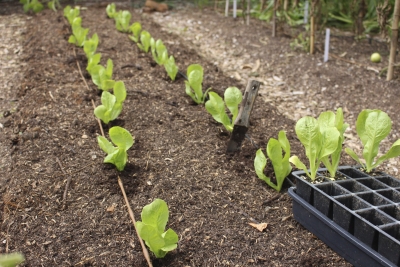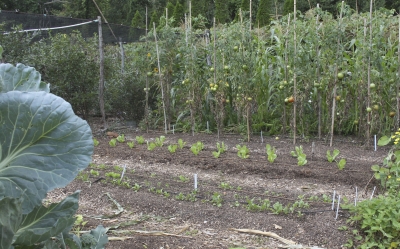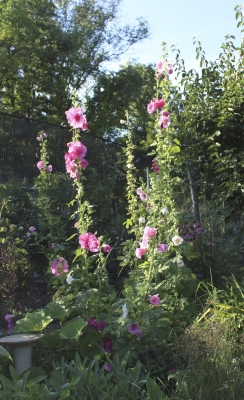End of Summer? Enter the Fall Garden.
/2 Comments/in Gardening, Planning, Vegetables/by Lee ReichFading Summer Brings in Fall Greens, and Hollyhocks for Cheer
There’s a flurry of seed sowing and setting out of transplants going on here. Am I deluded that it’s springtime? No. Autumn is around the corner and there are vegetables to be planted.
For many gardeners, summer’s end and the garden’s end are one and the same. But planning for and planting an autumn vegetable garden bypasses the funereal look of waning tomatoes, peppers, cucumbers, and other vegetables that thrive only with summer heat and long days of sunshine, and puts plenty of fresh vegetables on the table. Having an autumn vegetable garden is like having a whole new garden, one that gradually fades in, like a developing photograph, as summer vegetables fade out.
Which is why today I tucked two dozen endive transplants into a double row of holes spaced fifteen inches apart in a three-foot-wide bed. And which is why, in a different bed two weeks ago, I sowed a row of Watermelon winter radishes (the resemblance to watermelon only in the color of their innards), a row of turnips, and a row of Chinese cabbage. Also, why back in March, seeds of Brussels sprouts were sown, the seedlings of which were transplanted to yet another bed last May.
Not that the time has passed for planting any autumn vegetables; plenty of vegetables that enjoy the cool moistness of autumn are still to be sown. This week, I plant to sow lettuce, spring radishes, arugula, mustard, and spinach.
Edamame Out, Endive In
The question might arise as to where to plant all these autumn vegetables when the garden is already overflowing with summer vegetables. Overflowing, really?
I planted the endive transplants in a bed that I had just cleared of edamame plants; edamame bear over a period of a couple of weeks and then they’re done, which they were. Likewise, a whole bed of onions and a first planting of corn are finishing up, freeing up space for planting. Even the bed from the second planting of corn will be freed up the end of August.

Harvest of bush beans does not halt as abruptly as that of corn, onions, or edamame. Nonetheless, the bean harvest does begin to taper down after two or three weeks, so out went the first planting of bush beans a couple of weeks ago. A second planting, sown in a different bed three weeks after the first planting, took up the slack, and today I’m pulling even those plants out of the ground. Pole bean plants will keep green beans on our plates until frosty weather, which it what it takes to put a stop those plants.
Can’t Help But Smile With Hollyhocks
My garden isn’t only about food. I’m also sowing some flower seeds now, not to blossom in autumn but to get a jump on next spring.
This past spring I sowed seeds of Apricot-Peach Parfait hollyhocks (from https://www.reneesgarden.com). Right now, the plants’ seven-foot-high spires are studded along their length with frilly blossoms in delicious shades of apricot and rosy-peach. I want more.
Hollyhock self-seeds so future population growth could be left to the vagaries of nature and weather. But overly diligent weeding or mulching might quash newcomers, so I’m going to sow more seeds. Hollyhock is a biennial or short-lived perennial so that self-seeding habit is welcome.
As either a short-lived perennial or biennial, hollyhocks tend to grow just leaves their first year and flower their second year — then die if they behave like a biennial, or go on to flower for more years if they are perennial. I was able to get flowers this season from spring-sown seeds because I planted the seed early and the seedlings spent their first few weeks of growth in the greenhouse. (Through breeding, some varieties of hollyhock behave as annuals, and bloom reliably their first year — but not as seven-foot-high spires.)
Planting the seed in late summer guarantees that the plants will bloom next year, and earlier than spring-sown plants. Cool weather of late fall and late winter helps trigger the flowering response.
Delphinium is another flower to sow this week. In addition to the advantages of enjoying spires of blue flowers earlier and more reliably next summer, delphinium seeds sprout more reliably if fresh, which they are more likely to be in autumn than the following spring. Chilling the dry seed — some sources suggest stratification, that is, chilling the moist seed — for a week or so also is said to help wake it up.
Once seedlings of hollyhocks and delphiniums get going, they’ll need special accommodations to get through winter. After all, they’ll still be tender, baby plants when the weather turns frigid. The goal is to keep them alive and growing slowly going into winter. I’ll either tuck the pots close together in the cold frame or in the slightly warmer large window in my barely heated basement.
WESTWARD HO, FOR FRUIT MEETINGS AND EATINGS
/3 Comments/in Fruit, Gardening/by Lee ReichFruit Nuts, Including Me, Nurseries, & Wild Blueberries
Are there organizations for people who make and eat cheese; build and ride motorcycles; write and read books; grow and savor fruits? All I know is that the answer to the existence of the last-named organization is a rowsing “yes!” I know because I recently returned from Oregon, where I converged with other fruit nuts for the annual meeting of North American Fruit Explorers (www.nafex.org, and nuts, incidentally, are also covered under the organization’s umbrella).
No need to don a pith helmet and traipse off to Borneo to be a fruit explorer. Not that you couldn’t, and be one. No, this fun meeting brought together everyone from backyard growers with a few fruit plants to AN 88-year-old guy who grows over 3,000 varieties of apples. Fruits represented ranged from apples and pears to pawpaws and persimmons and, even more rare, haskaps and gumis. These people, we, realize that there’s a lot more to enjoy in the world of nature’s desserts — fruits, that is — than what you see on display in the supermarket, even farmers’ market.
What appeared to be a roomful of normal people was actually a roomful of fruit nuts, among which I count myself. NAFEX members are as varied as the fruits they grow, with all ages, genders, home towns, and “real jobs” represented. Members can share their trials, tribulations, and rewards of fruit growing (the title of my lecture there), ask questions, and exchange plants in their quarterly publication.
Each year’s annual meeting is at a “fruitful” location. Last week’s meeting took in tours of the USDA germplasm repository, which houses the USDA collection of pears, gooseberries, currants, and bramble fruits, and of research centers on hazelnuts and brambles. All accompanied, of course, by tastings. If you love fruit, grow some . . . and join NAFEX.
Branching Off to Pakistani Mulberries, Delectable Crabs, and More
I branched off (pardon the pun) from the group to visit a few nurseries. First stop was Whitman Farms (www.whitmanfarms.com), at which I made a beeline to Lucille Whitman’s black mulberry (Morus nigra) tree, an offshoot of which I’ve grown for many years. I grow it in a pot because it’s a subtropical species, not cold-hardy here. It’s worth the effort because it is among the most delectable of fruits. It’s hard to imagine that such a small berry can pack such a wallop of rich, sweet-tart flavor, much better than the wild mulberries around here. Lucille also grows a slew of gooseberry and currant varieties, another group of fruits that worthy of wider attention.
From there it was on to Burnt Ridge Nursery (www.burntridgenursery.com), worth visiting also for its panoramic view of the Cascade Mountains, including Mount Saint Helens. I soon realized, driving down the gravel nursery road, that we were passing through a virtual Garden of Eatin’, with apples and pear trees, grapes, and hardy kiwi vines. The forest of large trees turned out to be a nursery owner Michael Dolan’s extensive collection of chestnuts. It was too early in the season to taste any chestnuts but I did get to taste his Black Pakistani mulberry, which had a chewy texture and perhaps even richer flavor than black mulberry. (Black Pakistani is a variety of M. alba, white mulberry.) Another plus for Black Pakistani is that its fruit is two or more inches long. (Lucille Whitman also sells Black Pakistani. Note to myself: Get a Black Pakistani tree to grow in a pot, like a fig.)
Finally, I motored along with Sam Benowitz north to Washington state, to his nursery, Raintree Nursery (www.raintreenursery.com). We were greeted at the nursery entrance by espaliered apple trees, then plum trees whose branches bowed
low from their load of fruit. A Centennial crabapple tree splayed out its small but ripe fruits, which were delicious, especially for a summer apple. Another note to myself: Purchase or make a Centennial crabapple. Pots of lingonberries were lush with their shiny evergreen leaves, the size of mouse ears; persimmons leaves hung languidly from the trees’ branches; and hardy kiwifruit brightened up the scene with silvery variegation, blushed with pink. Alas, these fruits were not yet ripe so for the time being provided only eye candy.
They Call Them Huckleberries
Fruit nuts are a friendly fraternity, ready to share experiences and fruit. Blueberries are among my favorite fruits, and my newfound, northwestern friends were anxious to introduce me to some western blueberry species. First was red huckleberry (V. parvifolium). Not to be an ingrate, but . . . yuk! A very small, very tart, red blueberry. Perhaps the red color threw me off. Next came evergreen huckleberry (V. ovatum), much tastier, and evergreen, but still not holding a candle to our eastern blueberry species.
Finally, though, I had a taste of mountain huckleberry (V. membranaceum). Delicious. Different but as good as our east coast species.
I was given some leafy stems of mountain huckleberry packed for travel with their bases in water tubes and their leaves wrapped in moist tissue. As soon as I got
home I stripped all but the upper two leaves from the stems and inserted their bases into the mix of moist peat and perlite in my makeshift propagator. The propagator sits on the north side of my house, its clear plastic cover maintaining sufficient humidity while letting in sufficient light until the cuttings root — I hope. Blueberry species are not particularly easy to root, although one of the main ingredients needed is patience. I’ll also sow seeds of the few fruits I brought home.
In a few years, my memories of last week’s journey may also live on in my taste buds.








